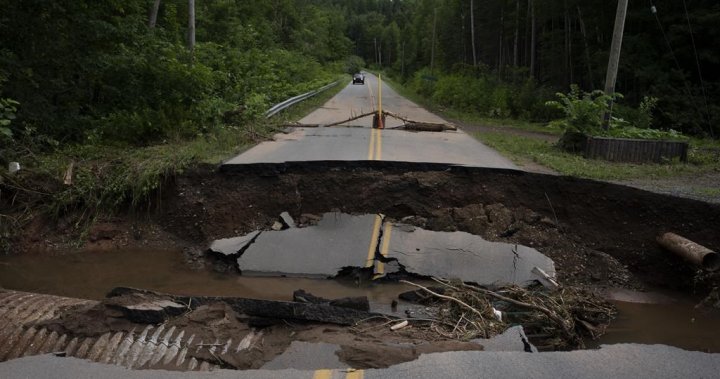
‘Complacency’ blamed for N.S. struggles with flooding, other climate disasters
Global News
Poor weather forecasts, inadequate cell service, and a lack of flooding disaster plans are several factors that were cited as to why N.S. was badly prepared for the severe weather.
On the night floodwaters swept through his Nova Scotia county, taking lives and tearing out bridges, Doug Pynch says he had trouble believing an emergency alert that flashed across his phone.
It called for residents to evacuate to a civic centre in Newport, N.S., a community that was already seeing water accumulating in low-lying areas. The retired deputy fire chief said he soon found himself having to transport people in his large truck, as cars couldn’t cross an intersection where water was pooling.
“That alert distracted us from doing other things, rescues that needed to be done. Now we had multiple other situations we had to deal with first,” he said in an interview this week. “I couldn’t allow them to drive through that water.”
In portions of Halifax and central Nova Scotia, as an estimated 250 millimetres of rain fell last weekend, similar confusion and improvisation was unfolding, in what some experts say is the latest example of the province’s inadequate state of preparation for climate disasters.
The mayor of the Municipality of West Hants has said many residents reported they didn’t receive any emergency alert at all because of the area’s spotty cellular service.
Meanwhile, the managers of the Minas Basin Pulp and Paper Ltd.’s dam system on the St. Croix River said Thursday during a tour that two employees were assigned at about 2 a.m. on July 22 to open spillways to take pressure off a large dam facing massive water pressures about 10 kilometres upstream.
Randy MacMillan, chief executive of Scotia Investments Ltd. — the dam’s owner — told deputy prime minister Chrystia Freeland during her visit that the water coming down was far exceeding Environment Canada forecasts.
“We were told we were getting 40 millimetres of water, but I think we topped out at over 300 millimetres. If you don’t have a forecast you can rely on, you have to take safe steps to keep people safe,” he told the minister.

 Run 3 Space | Play Space Running Game
Run 3 Space | Play Space Running Game Traffic Jam 3D | Online Racing Game
Traffic Jam 3D | Online Racing Game Duck Hunt | Play Old Classic Game
Duck Hunt | Play Old Classic Game











